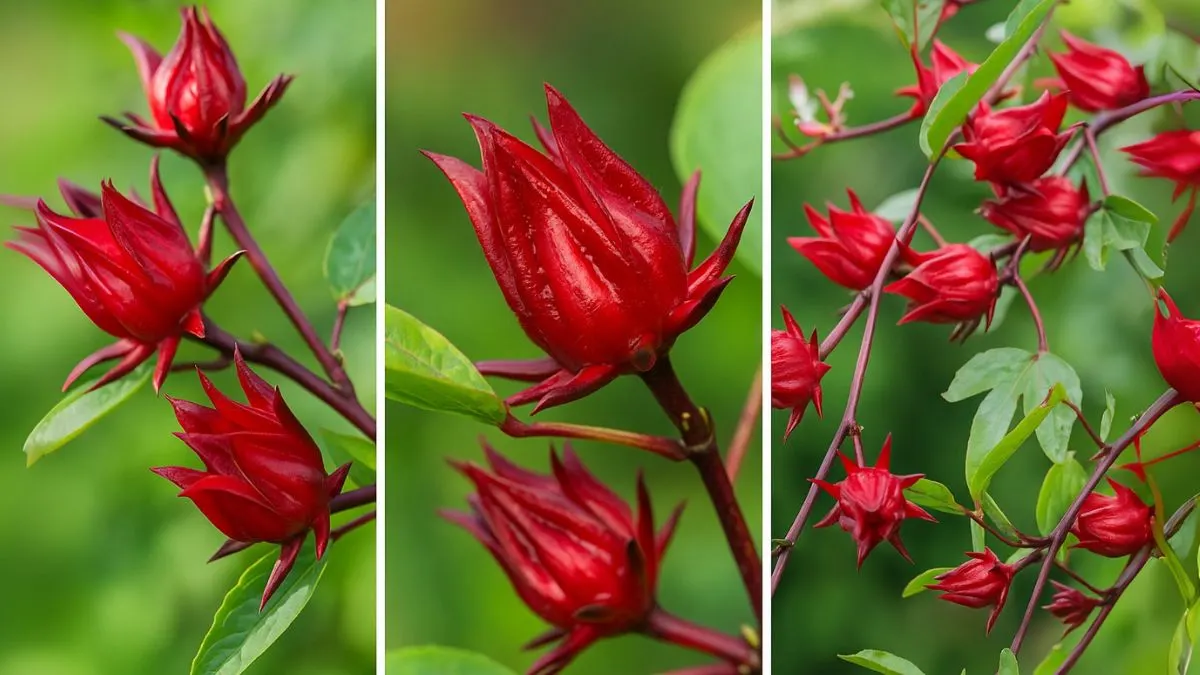When you think of edible plants, leafy greens and fruits often come to mind. But there’s one plant that blends beauty, nutrition, and flavor in a single package—the Roselle plant. Famous for its brilliant red flowers and tangy taste, it’s more than just ornamental. It’s a tropical and subtropical flowering plant known for its edible, fleshy red calyces, which surround the seed pod, and it has been part of global cuisine for centuries.
I first encountered Roselle while travelling through Southeast Asia, where it was brewed into a refreshing ruby-red tea on a hot afternoon. That sip instantly made me a lifelong fan.
What Makes Roselle Unique?

The charm of Roselle lies in its versatility.
- Roselle shrubs feature edible calyces, the fleshy parts around the seed pods that turn crimson as the flower matures.
- The part of the plant that is edible are the calyces of the roselle flower, and they’re prized for their tangy, cranberry-like flavor.
- Interestingly, Roselle’s flowers, leaves and pods are all edible, meaning the entire plant has culinary and medicinal value.
This rare quality makes it one of the most valuable edible ornamental plants in gardens worldwide.
Culinary Uses of Roselle
One of the most popular ways to enjoy this plant is through beverages:
- Brewing its flowers into a tangy, crimson-colored tea is common in countries like Egypt, Jamaica, and India.
- The tea is not only delicious but also rich in antioxidants and vitamin C.
- In gourmet dining, these flowers are sold as wild hibiscus flowers in syrup, used to garnish cocktails, desserts, and salads.
At home, I’ve used Roselle jam on warm toast—it’s tart yet sweet, reminding me of cranberries.
Also Read: How to Plant and Grow Hydrangeas at Home
Edible Parts of Roselle
While most people know about the calyces, the plant offers more:
- Calyces – The showstopper, edible both fresh and dried.
- Leaves – Slightly sour, often used in soups, stews, and chutneys.
- Pods – Tender pods can be cooked as vegetables.
- Flowers – Fresh flowers can be infused into syrups or desserts.
In short, it has edible leaves, flowers and calyces, making it a true farm-to-table star.
Nutritional & Medicinal Benefits
Beyond taste, Roselle is celebrated for health benefits:
- Rich in vitamin C, calcium, and iron.
- Supports digestion and helps reduce inflammation.
- Traditional medicine uses extracts for lowering blood pressure and improving liver health.
- The whole plant can be used as beverage, herbal remedy, or culinary ingredient.
This combination of beauty and function explains why Roselle has spread far beyond its tropical origins.
Growing Roselle at Home
If you’re inspired to grow it, here’s how:
Growing Requirement |
Details |
Climate |
A tropical and subtropical flowering plant that thrives in warm conditions |
Soil |
Well-drained, fertile soil |
Watering |
Moderate; avoid waterlogging |
Light |
Full sun for 6–8 hours |
Harvest |
Pick calyces when they turn red and fleshy |
In my garden, I found Roselle surprisingly easy to grow. With enough warmth and space, it thrives—even in pots.
Roselle in Global Cuisine
- In Jamaica, Roselle tea is a Christmas tradition.
- In India, the leaves are used in chutneys and curries.
- In Australia and Europe, gourmet markets sell wild hibiscus flowers in syrup, often used in champagne.
- In North America, health-conscious consumers enjoy it as herbal tea.
No matter where you live—in Canada, the USA, or elsewhere—Roselle has found its way into kitchens.
Also Read: 5 Gorgeous Lavender Varieties That Bring Relaxation and Aroma
Personal Perspective: Why I Love Roselle
What makes me love Roselle isn’t just its flavor. It’s the way it connects cultures. From a Caribbean Christmas drink to an Asian soup, it ties together traditions. Having grown it in my backyard, I appreciate how its shrubs feature edible calyces that turn every harvest into something exciting—whether it’s tea, jam, or syrup.
A Flowering Delight Worth Trying
To sum up:
- Roselle’s flowers, leaves and pods are all edible.
- The part of the plant that is edible are the calyces of the roselle flower, cherished for their tangy flavor.
- Whether you’re brewing Roselle flowers into a tangy, crimson-colored tea or buying flowers sold as wild hibiscus flowers in syrup, you’re enjoying a piece of global heritage.
- The whole plant can be used as beverage, medicine, or food.
👉 If you’re looking for a tropical and subtropical flowering plant known for its edible, fleshy red calyces, which surround the seed pod, the Roselle plant deserves a place in your garden and your kitchen.






